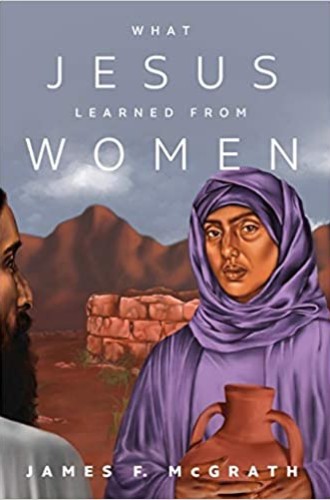A male scholar looks at the Bible’s women
According to James McGrath, unless Jesus was able to learn from others, he wasn’t truly human.
When I picked up this book and scanned the table of contents to see which biblical women James McGrath writes about, I admit that I made some hasty judgments. What will he—a male scholar—add to what I have learned, studied, preached, and taught for the last 40 years about these women of the Gospels? Also, I thought, he’d better not make Jesus “the exceptional Jew,” portraying Jesus as good by making all other Jews look bad! Then when I flipped through the chapters and saw that each scholarly examination is preceded by an imaginative fictional narrative, I wondered if the book was going to be schmaltzy.
As if he could read my (unkind) thoughts, McGrath meets each of these prejudgments head-on in the book’s introduction. He makes the case that male scholars should be exploring women in the scriptures because women’s studies have been marginalized instead of normalized. In most pulpits and study groups in church basements and living rooms, the male perspective that has come down through history gets repeated. Men and women need to do the scholarship, McGrath contends. He notes that he has surrounded himself with women scholars and conversation partners to sharpen his own thinking.
Read our latest issue or browse back issues.
He also clearly identifies the potential pitfall of making Jesus the exceptional Jew. “Denigrating Judaism to elevate Jesus simply will not do. Jesus was a Jewish man in a Jewish context, and it is thoroughly implausible to think in terms of Jesus vs. Judaism.” McGrath follows his own advice on this matter throughout the book. If anything, he makes Jesus into the exceptional man.
As for the fictionalized narratives from the Gospel women’s perspectives, some are better than others. Each of them frames the book’s scholarly insights about a biblical woman with a unique voice that shows what may have informed her life as she met Jesus. A male scholar giving a woman her voice could be problematic. But in these sections McGrath seems to have leaned heavily on the chorus of women scholars and readers who gave input as he wrote the book, and undoubtedly their feedback paid off.
McGrath draws connections between various texts to give readers new insights and evoke appreciation for the New Testament’s women. For instance, his approach to the woman at the well (John 4:1–42) is not to portray her as an adulterous sinner who is shunned by everyone in her town. If she were, he asks, why would everyone follow her back to meet Jesus? Instead, McGrath portrays her as the real person behind Jesus’ hypothetical teaching in Mark 12:18–27, Matthew 22:23–32, and Luke 20:27–38.
In these three passages, the Sadducees ask Jesus whose wife a woman would be after the resurrection of the dead if she’d been given in levirate marriage seven times over. The Gospel of John doesn’t have this encounter between the Sadducees and Jesus. But it does have the story of the woman at the well, and McGrath makes the case that she was in a levirate marriage, having been given to one brother after another until no brother remained to be legally married to her. This interpretation evokes Judah, who failed to provide for his daughter-in-law, Tamar, after her husband died without leaving an heir.
McGrath comes at this possibility from multiple scriptural, scholarly, historical, and cultural angles. For instance, he writes, “For the Sadducees this was a mere puzzle, a trap to try to snare him with. For Jesus, perhaps what was most troubling about these Sadducees was not their denial of the resurrection, but their use of the scenario they described as though it were a mere thought experiment and not a story of deep tragedy and loss.” McGrath offers his reading of the story gently, leaving readers to decide whether they will receive it. His approach here, as throughout the book, is open and unforced, aimed at maintaining the integrity of scripture as a gift received through the Holy Spirit to guide and inspire each person.
Mary Magdalene has also suffered from an interpretation that harbors little scholarship and yet is accepted by many readers of the Gospels. McGrath notes that in the sixth century Pope Gregory conflated the sinful woman of the city (Luke 7:36–50) with Mary Magdalene. Citing the story of seven demons being expelled from Mary Magdalene (Luke 8:2) and interpreting them as the seven deadly sins, Gregory argued that she must have been either a prostitute or otherwise sexually sinful.
With this sexualized interpretation of Mary Magdalene’s sinfulness came the visualization of her as a prostitute in classical art throughout history, and more recently in movies and sensationalized fiction. McGrath’s scholarship on Mary Magdalene isn’t particularly new, but he offers an enlightening picture of what demons meant in her culture and depicts how quickly and decidedly sinfulness in women is sexualized. Such misogynistic interpretations have become the gospel to many, closing off further inquiry into who the New Testament’s women may have been and why that matters to us.
To counter the suggestion that because Jesus was divine he didn’t need to learn anything from anybody, McGrath repeatedly emphasizes that unless Jesus was able to learn, he wasn’t truly human. In addition to naming what Jesus may have learned from each of these women, McGrath makes the case that we have something to learn from them too. By offering us new perspectives and creative connections, he helps us create new lenses for viewing the Gospel women.






